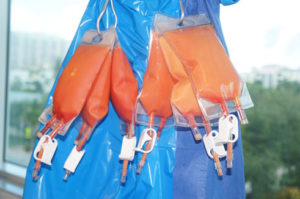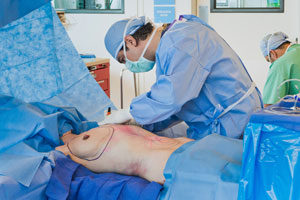Surgical Technique for Fat Transfer
How The Fat is Harvested
The areas to harvest fat are marked the day of surgery, and usually I focuse on areas that will sculpt your body, and include bilateral flanks (give you nicer looking hips), abdomen (decrease your belly), lower back (augment and lift your buttocks) and inner thighs (get rid of the excess fat that touch between your legs). (Photos of marking prior to surgery for both cosmetic and reconstructive).
Patient then undergoes general anesthesia, and I begin by gently infiltrating the areas of liposuction with a solution made of physiological lactated ringers with 1:100,000 of epinephrine. I then harvest fat using a special cannula and device that provides a constant low pressure which efficiently and atraumatically collects fat cells into a closed sterile system, which prevents exposure to the environment, and adheres to all principles of fat grafting (photos of me obtaining the fat grafts).


Preparation of The Fat
Each bag that is filled with lipoaspirate is either centrifuged at 15G for 1 min or allowed to separate by gravity at 1G for 15 min, both techniques arrive at the same results. Then the tumescent fluid is removed from the bag preserving and concentrating the harvested fat for grafting (photos of fat concentrated in bags).


Fat Transfer and Lift
The fat is carefully and diffusely disperse as fine mists of micro-droplets of fat that are not bigger than 2mm to prevent placement of larger blobs. This is performed through multiple small puncture holes at the bottom periphery of the breast (to prevent any visibility in a truly scarless procedure). The aim is to achieve evenness with randomness of grafting, as we add volume and correct any contour irregularities, and avoid large clumps of fat that ultimately lead to either fat necrosis or lipid cysts. The cannula used gently glides through the breast tissues and prevents any undo trauma (photo of fat transfer breast augmentation).





